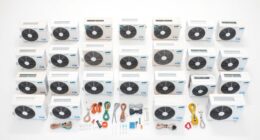Want to increase the energy efficiency of your heat pump? You’ve come to the right place! In this article, we will share practical tips and expert advice to help you get the most out of your system.
Discover how understanding energy efficiency ratings, avoiding common mistakes, and scheduling regular maintenance can make a significant difference in your energy bills and environmental impact.
Let’s dive in and explore the secrets to improving your heat pump’s energy efficiency together.
Key Takeaways
- Regularly clean or replace air filters to ensure smooth airflow
- Properly insulate ductwork to prevent heat loss and improve efficiency
- Use a programmable thermostat to maintain a consistent temperature
- Regular maintenance ensures optimal performance and minimizes energy waste
Understanding Heat Pump Energy Efficiency Ratings
We can improve our understanding of heat pump energy efficiency ratings by familiarizing ourselves with the different rating systems and what they mean.

Heat pump energy efficiency ratings are an important factor to consider when looking to maximize heat pump energy savings and reap the benefits of heat pump energy efficiency.
These ratings provide valuable information about the performance and efficiency of heat pumps, allowing us to make informed decisions about which model to choose.
The most common rating system used for heat pumps is the Seasonal Energy Efficiency Ratio (SEER). SEER ratings indicate the cooling efficiency of a heat pump, with higher numbers representing greater energy efficiency.
Another rating system to be aware of is the Heating Seasonal Performance Factor (HSPF), which measures the heating efficiency of a heat pump.

Tips for Increasing Your Heat Pump’s Energy Efficiency
Let’s explore some practical tips for boosting our heat pump’s energy efficiency.
Regular heat pump maintenance is crucial for optimal performance and energy savings. Start by cleaning or replacing the air filters every month to ensure smooth airflow and reduce strain on the system.
Additionally, check and clean the outdoor coil regularly to remove any debris that may obstruct airflow. Proper insulation around the ductwork can prevent heat loss and improve overall efficiency.
It’s also important to maintain a consistent temperature by using a programmable thermostat and avoiding frequent adjustments.

Lastly, consider installing a heat pump cover or shelter to protect it from harsh weather conditions.
The Environmental Impact of Heat Pump Energy Efficiency
Improving the energy efficiency of our heat pump has a positive impact on the environment by reducing greenhouse gas emissions and conserving natural resources. By utilizing sustainable heating methods, we can greatly reduce our carbon footprint and contribute to a healthier planet.
Heat pumps are an environmentally-friendly alternative to traditional heating systems, as they transfer heat rather than generate it. This process requires less energy and results in lower emissions. By investing in an energy-efficient heat pump, we not only reduce our energy consumption but also decrease our dependence on fossil fuels.
This shift towards sustainable heating not only benefits the environment but also promotes a greener and more sustainable future for generations to come.

Now, let’s explore some common mistakes that can hinder heat pump energy efficiency.
Common Mistakes That Affect Heat Pump Energy Efficiency
Using incorrect thermostat settings is a common mistake that can negatively impact heat pump energy efficiency. Optimizing thermostat settings is crucial for achieving maximum comfort and energy savings. To help you avoid these common mistakes, here are some important tips for heat pump troubleshooting and optimizing thermostat settings:
| Common Mistakes | Solutions |
|---|---|
| Setting the thermostat too high or too low | Set the thermostat to the desired temperature, typically around 68-72°F for heating and 72-76°F for cooling. Avoid extreme temperature settings as it can put unnecessary strain on the heat pump. |
| Constantly adjusting the thermostat | Set the thermostat to a comfortable temperature and leave it alone. Constantly adjusting the settings can lead to inefficient operation and higher energy consumption. |
| Ignoring programmable thermostat features | Take advantage of programmable thermostats to schedule temperature adjustments based on your daily routine. This can help optimize energy efficiency and save money. |
| Neglecting regular thermostat maintenance | Clean the thermostat regularly to remove dust and debris that can affect its accuracy. Additionally, replace the batteries as needed to ensure reliable performance. |
How Regular Maintenance Can Improve Heat Pump Energy Efficiency
Regular maintenance is essential in improving our heat pump’s energy efficiency. By regularly maintaining our heat pump, we can ensure that it operates at its optimal level, minimizing energy waste and maximizing performance.
One of the key benefits of heat pump maintenance is improved energy efficiency, which translates into lower energy bills and reduced carbon footprint. Regular maintenance tasks include cleaning and replacing air filters, checking and cleaning coils, inspecting and lubricating fan motors, and ensuring proper refrigerant levels.

These maintenance activities help to improve air flow, reduce strain on the system, and enhance heat transfer efficiency. In addition to regular maintenance, there are a few energy-saving heat pump tips that can further improve efficiency, such as adjusting thermostat settings, utilizing programmable thermostats, and keeping the outdoor unit clear of debris.
Frequently Asked Questions
Is It Possible to Improve My Heat Pump’s Energy Efficiency Without Replacing It?
Yes, we can improve our heat pump’s energy efficiency without replacing it. Upgrading options and energy saving tips can help maximize its performance, reduce energy consumption, and save money in the long run.
How Can I Determine the Energy Efficiency Rating of My Existing Heat Pump?
To determine the energy efficiency rating of our existing heat pump, we should consult the manufacturer’s specifications or look for the Energy Star label. Comparing models will help us identify more efficient options.
Are There Any Government Incentives or Rebates Available for Upgrading to a More Energy-Efficient Heat Pump?
Yes, there are government incentives and rebates available for upgrading to more energy-efficient heat pumps. These incentives aim to promote the use of energy-efficient appliances and provide financial assistance to consumers.

Can Using a Smart Thermostat Help Improve My Heat Pump’s Energy Efficiency?
Using a smart thermostat can greatly improve our heat pump’s energy efficiency. It allows us to easily control and schedule temperature settings, saving energy and reducing costs. It’s one of many energy-saving tips we can implement.
What Are Some Signs That My Heat Pump May Be Operating Inefficiently and in Need of Maintenance?
We’ll start by discussing signs of heat pump inefficiency and the importance of maintenance. Regular maintenance is crucial for optimal energy efficiency. Look out for reduced heating or cooling, strange noises, and higher energy bills.
Conclusion
In conclusion, it’s absolutely imperative that we take every measure possible to enhance the energy efficiency of our heat pumps.
Failing to do so would be like leaving money on the table, or worse, contributing to the environmental degradation that plagues our planet.

By understanding energy efficiency ratings, implementing simple tips, avoiding common mistakes, and performing regular maintenance, we can ensure that our heat pumps operate at peak efficiency.
Let’s join forces in this noble pursuit of energy efficiency and save both our wallets and the Earth.









